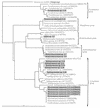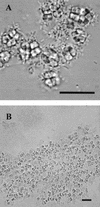Phylogenetic relationships and coaggregation ability of freshwater biofilm bacteria
- PMID: 12089055
- PMCID: PMC126804
- DOI: 10.1128/AEM.68.7.3644-3650.2002
Phylogenetic relationships and coaggregation ability of freshwater biofilm bacteria
Abstract
Nineteen numerically dominant heterotrophic bacteria from a freshwater biofilm were identified by 16S ribosomal DNA gene sequencing, and their coaggregation partnerships were determined. Phylogenetic trees showed that both distantly related and closely related strains coaggregated at intergeneric, intrageneric, and intraspecies levels. One strain, Blastomonas natatoria 2.1, coaggregated with all 18 other strains and may function as a bridging organism in biofilm development.
Figures





Similar articles
-
Coaggregation between freshwater bacteria within biofilm and planktonic communities.FEMS Microbiol Lett. 2003 Mar 14;220(1):133-40. doi: 10.1016/S0378-1097(03)00094-6. FEMS Microbiol Lett. 2003. PMID: 12644239
-
Influence of growth environment on coaggregation between freshwater biofilm bacteria.J Appl Microbiol. 2004;96(6):1367-73. doi: 10.1111/j.1365-2672.2004.02297.x. J Appl Microbiol. 2004. PMID: 15139931
-
Shear rate moderates community diversity in freshwater biofilms.Appl Environ Microbiol. 2004 Dec;70(12):7426-35. doi: 10.1128/AEM.70.12.7426-7435.2004. Appl Environ Microbiol. 2004. PMID: 15574945 Free PMC article.
-
Microbial community composition and function in wastewater treatment plants.Antonie Van Leeuwenhoek. 2002 Aug;81(1-4):665-80. doi: 10.1023/a:1020586312170. Antonie Van Leeuwenhoek. 2002. PMID: 12448762 Review.
-
Bacterial coaggregation in aquatic systems.Water Res. 2021 May 15;196:117037. doi: 10.1016/j.watres.2021.117037. Epub 2021 Mar 10. Water Res. 2021. PMID: 33751976 Review.
Cited by
-
Peritonitis caused by Blastomonas natatoria in a patient submitted to peritoneal dyalisis.Rev Esp Quimioter. 2018 Apr;31(2):175-177. Epub 2018 Apr 2. Rev Esp Quimioter. 2018. PMID: 29616514 Free PMC article. No abstract available.
-
Production of cell-cell signalling molecules by bacteria isolated from human chronic wounds.J Appl Microbiol. 2010 May;108(5):1509-22. doi: 10.1111/j.1365-2672.2009.04554.x. Epub 2009 Sep 21. J Appl Microbiol. 2010. PMID: 19840177 Free PMC article.
-
Coaggregation among nonflocculating bacteria isolated from activated sludge.Appl Environ Microbiol. 2003 Oct;69(10):6056-63. doi: 10.1128/AEM.69.10.6056-6063.2003. Appl Environ Microbiol. 2003. PMID: 14532062 Free PMC article.
-
Interaction of Legionella pneumophila and Helicobacter pylori with bacterial species isolated from drinking water biofilms.BMC Microbiol. 2011 Mar 18;11:57. doi: 10.1186/1471-2180-11-57. BMC Microbiol. 2011. PMID: 21418578 Free PMC article.
-
Comparing the chlorine disinfection of detached biofilm clusters with those of sessile biofilms and planktonic cells in single- and dual-species cultures.Appl Environ Microbiol. 2011 Oct;77(20):7176-84. doi: 10.1128/AEM.05514-11. Epub 2011 Aug 19. Appl Environ Microbiol. 2011. PMID: 21856824 Free PMC article.
References
-
- Andersen, R. N., N. Ganeshkumar, and P. E. Kolenbrander. 1998. Helicobacter pylori adheres selectively to Fusobacterium spp. Oral Microbiol. Immunol. 13:51-54. - PubMed
-
- Bowden, G. H. W. 1999. Oral biofilm an archive of past events? p. 211-235. In H. N. Newman and M. Wilson (ed.), Dental plaque revisited: oral biofilms in health and disease. Bioline press, Cardiff, United Kingdom.
-
- Buswell, C. M., Y. M. Herlihy, P. D. Marsh, C. W. Keevil, and S. A. Leach. 1997. Coaggregation amongst aquatic biofilm bacteria. J. Appl. Microbiol. 83:477-484.
-
- Buswell, C. M., Y. M. Herlihy, C. W. Keevil, P. D. Marsh, and S. A. Leach. 1999. Carbon load in aquatic ecosystems affects the diversity and biomass of water consortia and the persistence of the pathogen Campylobacter jejuni within them. J. Appl. Microbiol. Symp. Suppl. 85:161S-167S. - PubMed
MeSH terms
Substances
Associated data
- Actions
- Actions
- Actions
- Actions
- Actions
- Actions
- Actions
- Actions
- Actions
- Actions
- Actions
- Actions
- Actions
- Actions
- Actions
- Actions
- Actions
- Actions
- Actions
LinkOut - more resources
Full Text Sources
Other Literature Sources
Molecular Biology Databases

